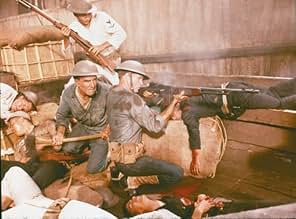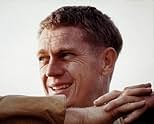
En 1926, un ingénieur naval américain est affecté à une canonnière pour une mission de sauvetage dans une Chine déchirée par la guerre.En 1926, un ingénieur naval américain est affecté à une canonnière pour une mission de sauvetage dans une Chine déchirée par la guerre.En 1926, un ingénieur naval américain est affecté à une canonnière pour une mission de sauvetage dans une Chine déchirée par la guerre.
- Nommé pour 8 Oscars
- 2 victoires et 21 nominations au total
- Maily
- (as Marayat Andriane)
- Shanahan
- (as Joseph di Reda)
Histoire
Le saviez-vous
- AnecdotesDirector Robert Wise was so proud of this movie that he held yearly parties with surviving cast members to celebrate it.
- GaffesDuring the battle scene at the blockade, Holman is sent forward on the port side with two men manning a B.A.R. position. When the main battery on San Pablo fires and hits the mast of a junk, a group of men near midships who are part of the boarding party are seen laughing, Holman being one of them.
- Citations
Frenchy Burgoyne: [exchanging marriage vows; slowly and with feeling] We're mixing our lives together, Maily, and we'll never be able to unmix them again, and we'll never want to. I take you for what you are, and all that you are, and mix you with all of me, and I don't hold back nothing. When you're cold, and hungry, and afraid, so am I. I'm going to stay with you all that I can, take the best care of you that I can, and love you 'til I die.
Maily: I will always love you and honor you and serve you, and stay as near to you as I can, and do everything for you, and live for you. I won't have *any* life except our life together. I will just love you, Frenchy, all of me, loving you forever.
- Crédits fousThere is a credit for 'Diversions by Irving Schwartz' in tribute to a mysterious, unknown correspondent whose letters proved a morale booster to cast and crew during trying location work in Hong Kong and Taiwan.
- Versions alternativesThe original "roadshow" version ran 196 minutes; later cut to its present length (182 minutes) for its general release. The roadshow version was included in a 2007 special edition DVD release, which provided the first viewing of this version since the original 1966 release.
- ConnexionsFeatured in Slaying the Dragon (1988)
- Bandes originalesSleepy Time Gal
(uncredited)
Music by Richard A. Whiting and Ange Lorenzo
Lyrics by Ray Egan and Joseph R. Alden
The movie follows the book closely, and as such is rich with subplot in a way that few motion pictures are. Those subplots are crucial to the impact of the whole. Time and again we are lead to believe this will be some uplifting tale of the underdogs triumphing and interracial harmony – for example Steve McQueen and Mako's working friendship or Richard Attenborough's romance with Marayat Andrienne – only to see the story take another shockingly dark turn and have all hopes dashed.
This was a pet project for producer-director Robert Wise, one he had worked hard to get off the ground and would later look back on as one of his proudest achievements. He brings it to the screen with his usual touch for flow and rhythm, with sudden shifts in tone, from frenzied action and rapid editing in another to languid long shots in another. We have on one hand the utter simplicity of the scene in which McQueen and Candice Bergen get to know each other on their steamer voyage – just two opposing shots, the river as a backdrop, the actors motionless as they speak their dialogue. Compare that to the boxing match between Mako and Simon Oakland, a quick-fire bout of agonising close-ups of contenders and crowd. The differences are not simply a case of editing and movement, but also the amount of business in the background, the distance the camera is from the action, and sometimes even the lighting and colour. And Wise doesn't call attention to the changes with sudden jolts – tension is built up gradually before giving way to scenes more tranquil.
Of particular note here is the set decoration. Of course, the story necessarily takes place in a series of small and squalid spaces – the bowels of the ship where McQueen works, the brothel where the men spend their shore leave – but it is the incredible production design by Boris Leven that makes it all so desolate. The interiors have rough, grey walls and small dirty windows, even the small chapel where the wedding takes place, which in spite of the scene has to be one of the most depressing sets ever made.
Tough action heroes like Steve McQueen may achieve stardom but they aren't normally praised for their acting skills. However The Sand Pebbles brings out something very deep in McQueen. He seems totally in tune with the picture's moodiness, bringing a lot of wordless emotion to his laconic character. At one point he breaks down in tears while shovelling coal; the camera is to his back but the moment is all as it should be in his body language. Another great but often overlooked player here is Simon Oakland. Oakland was great when you needed a small part with a lot of impact (see him at the end of Psycho for example) and was often a levelheaded authority figure. Less often was he cast as the bully, but he makes a decent job of it, being both threatening and repugnant. I'm less enthusiastic about Richard Attenborough's performance. For one thing he isn't right for the uniform – he looks like a little boy in a sailor suit – and for another he isn't right for the American accent, unless he was doing it as some kind of cultural revenge for Dick van Dyke's appalling attempt at being a cockney in Mary Poppins.
The Sand Pebbles is undoubtedly one of bleakest war movies ever made, but what is so different about it is not its anti-imperialist stance or even its downbeat mood. It is the fact that the US forces are shown to lose control of the situation. It was one of the great ironies with anti-war films like Apocalypse Now and Full Metal Jacket that apparently some youngsters were actually inspired to join the marines after seeing them. However I cannot imagine The Sand Pebbles having anyone rushing down to their nearest Navy recruitment office. Even though it does not exactly condemn servicemen or even the armed forces, it makes armed service look about as glamorous as cleaning a sewer. And rather than portraying the Americans as a conquering force – for good or bad – it shows them as lost, isolated and overwhelmed. There will be no cavalry riding to the rescue this time. And it creates this impression without ever losing respect for its principle characters, whom we are lead to pity rather than condemn. It shows war not as hell or as mass murder, but as bitter human tragedy.
Meilleurs choix
- How long is The Sand Pebbles?Alimenté par Alexa
Détails
- Date de sortie
- Pays d’origine
- Langues
- Aussi connu sous le nom de
- El cañonero del Yangtzé
- Lieux de tournage
- Sociétés de production
- Voir plus de crédits d'entreprise sur IMDbPro
Box-office
- Budget
- 12 000 000 $US (estimé)
- Durée3 heures 2 minutes
- Couleur
- Rapport de forme
- 2.35 : 1
Contribuer à cette page






































